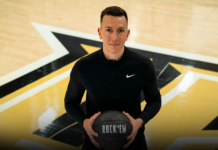The typical set-up of a UCF College Democrats table displays a light blue table cloth with fliers and merchandise spread across the top. On Wednesday, that was replaced by a poster labeled “Breaking Stereotypes,” balsa wood, and permanent markers.
Hosted by the Dems’ Asian-American Caucus, the event did exactly as advertised. Participants wrote their most hated statement attributed to their race and literally broke that stereotype in half.
The purpose, as described by caucus leaders, was to promote inclusiveness within the community by dispelling, in part, what is known as the model minority myth. Often used to describe Asians, the “model minority” is defined on a distributed flier as one “whose members are most often perceived to achieve a higher degree of socioeconomic success than the population average.” The term, the flier said, is used to counter calls for government action to reduce racial discrimination.
From pursuing STEM careers–a stereotype “broken” by political science and art history student Pratyush Goberdhan–to the common trope that Chinese students perform well at math, are some examples of misconceptions made about Asians that perpetuate the model minority.
Also, contrary to popular belief, Asians, which comprise six percent of the UCF student population, come from nationalities as far west as Turkey and as far south as Indonesia. Devi Mody, another co-founder of the Asian-American Caucus and the treasurer of the Dems, confronts the misconception as an Indian-American.
“Let me tell you, people in middle school–like, do they not realize that India is in Asia?” Mody asked with a chuckle. “India’s in Asia, therefore making us Asian. People have fought me on this, and I’m like ‘Google a map and you will see.'”
Indeed, many Asian students who participated in “breaking” their stereotypes did not fit the mythical profile, such as Sarah Siraj, a Pakistani student activist who wrote “Muslims are terrorists” on her board before splitting it in two.
Many stereotypes are considered paradoxically positive while possibly having negative implications, and some come as a result of confusing continental separation with racial profiles, but others range into the purely negative. An example of this is that Asian men are not masculine enough, an idea which Stephanie Slater, a co-founder of the caucus and a Chinese-born criminal justice student, said may be because of other cultural and physical misconceptions.
“People don’t think they are manly because ‘they don’t stand up for themselves, they’re not openly masculine,'” Stephanie Slater, a Chinese-born criminal justice student and a co-founder of the caucus, said. “They are shorter, which doesn’t help. And I think it’s because Asians are smart, so when you see them doing math all the time or engineering, you don’t typically see them as Superman.”
Slater herself breaks the trope of the homogeneous Asian family. While she was born in China, she and her twin sister were adopted by American parents and grew up in the United States with an English-language last name.
Having gone to school in Florida, she was taunted by her appearance and was called “chink,” a racial slur against Chinese people particularly and one which, she said, many Americans see nothing wrong with saying. She does, however, continue to learn more about Chinese culture and customs, something which she feels is part of the Asian-American experience.
“It’s very different for me because I grew up American, but to me it’s about being proud of where you come from, and I am proud of being Chinese,” Slater said. “When people ask me what I am, I say Chinese. I assume people know I am also American.”
Asian-Americans, while they were the primary target of Breaking Stereotypes, were not the only ones who sought to do so. One black student broke a board with “Watermelons” scribbled across it. A Colombian dispelled the stereotype that he sells cocaine. And another student confidently split a board with the words, “I shower with my hijab on.”






